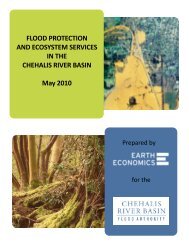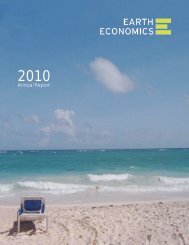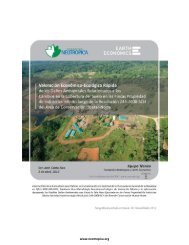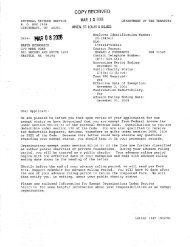The Spot Prawn Fishery: A Status Report - Earth Economics
The Spot Prawn Fishery: A Status Report - Earth Economics
The Spot Prawn Fishery: A Status Report - Earth Economics
Create successful ePaper yourself
Turn your PDF publications into a flip-book with our unique Google optimized e-Paper software.
<strong>The</strong> <strong>Spot</strong> <strong>Prawn</strong> <strong>Fishery</strong>: A <strong>Status</strong> <strong>Report</strong><br />
Fisheries Commission (NWIFC) represents 20<br />
treaty Tribes and has followed all stages of the<br />
Rafeedie case. <strong>The</strong> mission of the NWIFC is to<br />
assist “Treaty Indian Tribes in conducting biologically<br />
sound fisheries and providing a unified voice<br />
on fisheries management issues” (NWIFC 2000,<br />
www.nwifc.wa.gov). Approximately 16 Washington<br />
Tribes have a stated interest in the spot prawn<br />
fishery (David Fyfe, NWIFC. Pers. comm., June<br />
2001).<br />
Since Rafeedie, the Tribes “have a fundamental<br />
government duty to conserve and protect their<br />
treaty-reserved resources, while providing tribal<br />
harvest opportunity” (NWIFC 2000: p.4).<br />
Ensuring the development of sound data-management<br />
systems for catch reporting, research<br />
and assess-ment programs, and monitoring and<br />
enforce-ment regimes is a common goal of all<br />
Tribal shellfish management systems. <strong>The</strong> need<br />
to regulate and monitor the in-season fishery in<br />
order to ensure conservation of the resource and<br />
maintain a 50:50 allocation between Tribal and<br />
non-Tribal interests is specific to Tribal management.<br />
<strong>The</strong> development of “in-season population<br />
assess-ment methodologies is one of the goals of<br />
Tribal management systems and will require<br />
increased data collection and research” (NWIFC<br />
2000: p. 5).<br />
<strong>The</strong> Offshore <strong>Spot</strong> <strong>Prawn</strong> <strong>Fishery</strong><br />
<strong>The</strong> offshore, directed fishery for spot prawns<br />
began in approximately 1992, when two boats<br />
based in Westport, Washington actively targeted<br />
spot prawns with pot gear. Prior to this time, spot<br />
prawns were a bycatch species in the ocean pink<br />
shrimp and groundfish trawl fisheries. Bycatch or<br />
incidental catch declined sharply when WDFW<br />
instituted regulations that required a larger mesh<br />
size (WDFW 2001c). In the early developmental<br />
stages of the spot prawn fishery, only a few regulations<br />
were in place. <strong>The</strong>se included: 1) use of cotton<br />
For thousands of years, shellfish has<br />
been a vital food source for Washington’s<br />
Tribes, second only to salmon.<br />
Shellfish are equally important<br />
today for economic as well as subsistence<br />
and ceremonial purposes.<br />
Similar to salmon resources,Tribal<br />
rights to harvest shellfish are guaranteed<br />
in a series of treaties signed<br />
with representatives of the U.S. government<br />
in the 1850s.<br />
THE RAFEEDIE DECISION<br />
“<strong>The</strong> right of taking of fish at<br />
usual and accustomed<br />
grounds and stations is further<br />
secured to said Indians, in common<br />
with all citizens of the<br />
United States; and erecting<br />
temporary houses for the purposes<br />
of curing; together with<br />
the privilege of hunting and<br />
gathering roots and berries on<br />
open and unclaimed lands.<br />
Provided, however, that they<br />
take no shellfish from any beds<br />
staked or cultivated by citizens”<br />
(Treaty of Point No Point,<br />
Jan. 26, 1855, cited in<br />
Northwest Indian Fisheries<br />
Commission Comprehensive<br />
Tribal Shellfish Management.<br />
2000. www.nwifc.wa.gov/<br />
ctnrm/2000_shellfish.htm).<br />
Shellfish harvests were dominated<br />
by the Tribes until well into the<br />
1920s, but as settlement spread<br />
and available land was purchased,<br />
the Tribes were slowly pushed out<br />
of traditional fishing and harvesting<br />
grounds. Efforts to restore and<br />
uphold treaty rights began with the<br />
case U.S. v. Winans, in which the<br />
Supreme Court ruled that where<br />
treaties reserve Tribal rights to fish<br />
at “usual and accustomed fishing<br />
grounds, the State can not preclude<br />
access to those places” (NWIFC<br />
2000: p. 2). In 1970, the U.S. government<br />
filed a case on behalf of western<br />
Washington fishing Tribes<br />
against the State of Washington. In<br />
1974,“<strong>The</strong> Boldt Decision” ruled that<br />
the Tribes had a reserved right to<br />
half of the harvestable salmon and<br />
steelhead in western Washington.<br />
<strong>The</strong> U.S. Supreme Court upheld this<br />
decision in 1979.<br />
Since then, the Tribes and Washington<br />
State have been working to<br />
develop fishery management systems<br />
that ensure opportunities for<br />
both Tribal and non-Tribal fishers.<br />
Despite these efforts, the Tribes felt<br />
obliged to file suit in Federal Court<br />
to protect their treaty shellfish harvest<br />
rights.<strong>The</strong> issue went to trial in<br />
1994.This case followed the case<br />
law laid out in U.S. v. Washington<br />
(“<strong>The</strong> Boldt Decision”). Judge<br />
Rafeedie ruled that “the treaties ‘in<br />
common’ language meant that the<br />
tribes had reserved harvest rights.<br />
<strong>The</strong> tribes reserved the right to harvest<br />
up to half of all shellfish from all<br />
of the usual and accustomed places,<br />
except those ‘staked or cultivated’<br />
by citizens.” Rafeedie stated,“A<br />
treaty is not a grant of rights to the<br />
Indians, but a grant of rights from<br />
them” (NWIFC 2000: p. 3).<br />
All parties to the case have appealed<br />
various parts of Rafeedie’s ruling.<br />
<strong>The</strong> Ninth U.S. Circuit Court of Appeals<br />
heard these arguments in<br />
1997 and upheld Rafeedie’s major<br />
rulings. Portions of the implementation<br />
plan were changed. Appeals for<br />
a re-hearing from the State of<br />
Washington and private property<br />
owners were denied.<strong>The</strong> Tribes’<br />
appeal to change Rafeedie’s ruling<br />
that prevents the harvest of natural<br />
clams beneath growers’ cultivated<br />
oyster beds was also denied.<strong>The</strong><br />
decision became final in 1999, when<br />
the U.S. Supreme Court denied<br />
appeals of lower court rulings.<strong>The</strong><br />
Tribes have now “moved past the litigation<br />
and into co-management of<br />
their treaty resources with the State<br />
of Washington” (NWIFC 2000: p.3).<br />
27
















